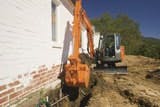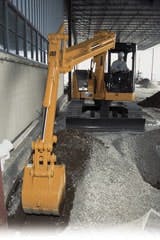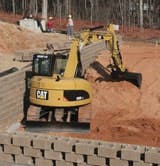- The Cost of Ownership
- Compact Crawler Excavator Specs (5 to 8 metric tons)
So, you're in the market for a compact crawler excavator. Or are you?
The question's intent is neither facetious nor whimsical. In reality, it can be rather difficult for equipment buyers to definitively peg what they want, given how different manufacturers define what is and what is not a compact or mini-excavator, or whether or not those two terms are even one in the same.
The classification of mini-excavators is defined as those up to 6 metric tons, or about 13,200 pounds. Although some OEMs hold true to that designation in the marketing of their smallest excavators, increasingly some do not. And whereas the latter group is comprised of such manufacturers as Gehl or Kubota that only offer compact excavators and, as such, are encompassing all of their models into their respective product families be those machines below 6 metric tons or not, there are other players like Caterpillar and JCB that offer product families of full-sized excavators and even beyond, yet are grouping their 8-metric-ton machines into their “mini” families.
In the case of Caterpillar, the migration of the 307 and 308 models down to the mini family from the small excavator family was customer-driven, says Darren Wilson, mini hydraulic excavator industry manager for North America.
“There are still a lot of applications where guys can use a 7- or 8-ton machine in the same job where they once used a 5- and 6-ton machine,” says Wilson. “They don't have to go to a lowboy to drag that 308 around. They can still pull it on their trailer behind a six-wheel truck.
“More than anything, what's happened is that the customer base that was using the 5- and 6-ton machine has the capacity to haul around a larger machine, and they have learned they can get a lot more work done.”
He cites excavation contractors who serve the residential pool market as a prime example of equipment users who benefit production-wise from the additional reach and less on-site repositioning required of a 308, while retaining the ability to move the machine from site to site as easily as the 305 model they might have used formerly.
Terex includes machines as large as the 12.5-metric-ton TC125 into its “compact” family, which reflects an extension of mini-excavator traits into larger sizes, says Bill Parker, compact excavator product manager.
“Actually, Terex broke it down very much like the market data does, where below 6 metric tons is what they call a mini-excavator, and above that they call it the 'midi'. Now that was the German definition, and for translation over here into North America it was combined into the compact group. Along with our mini-excavators, we have a 6-metric-ton, we have a 7.5-metric-ton and, as well, we have the 12.5-metric-ton,” says Parker. “I think, more than anything, compact was a marketing buzzword done to say, 'Hey, listen, we've got some larger excavators with shorter tail swing that'll help get us into some more restrictive landscape sites and job areas.' I think it just evolved.”
The “compact” TC125 remains, though, at or around 28,000 pounds.
“It's a machine that actually offers a little bit more than a standard 12- or 12.5-metric-ton excavator,” says Parker. “It actually competes upwards with our (30,500-pound) TXC140. From a dig perspective, it's got that performance, but what this offers is a dozer blade on the front, standard, that you don't get on some of these larger excavators. It's also a little bit unique with respect that it is the only one that we offer out of our compact product line that does not offer the articulated boom. Performance-wise, it's a dynamite machine . . . and it's got that reduced tail swing. It only extends out about 4.5 inches.”







